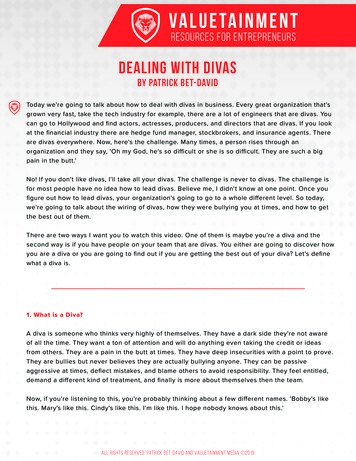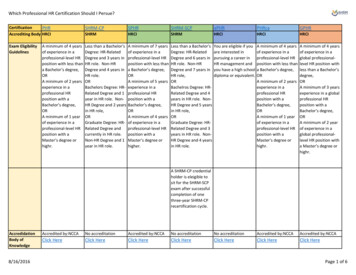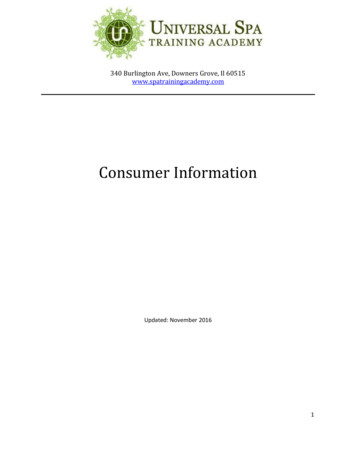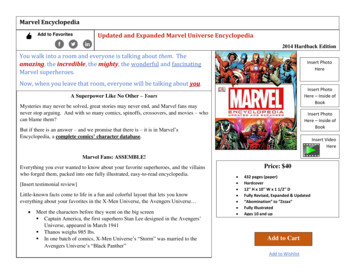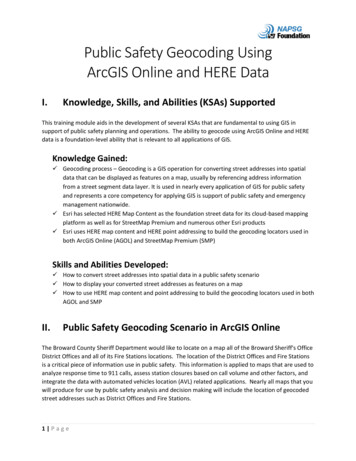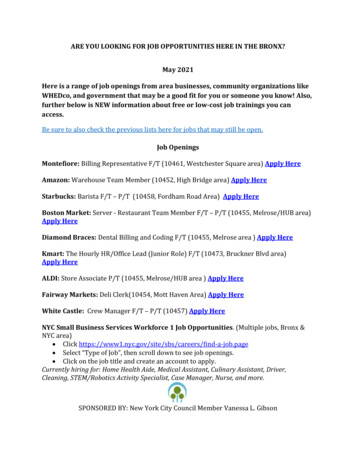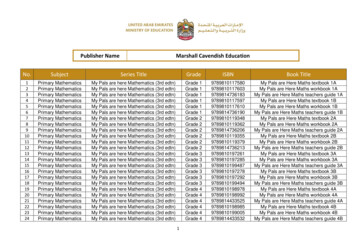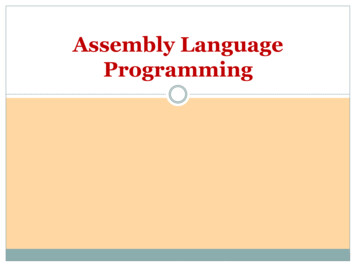
Transcription
Where to Go from Here
Taking Stock: Where Are We?
Goals for this Course Learn how to model and solvecomplex problems with computers.To that end: Explore common abstractions forrepresenting problems.Harness recursion and understand how tothink about problems recursively.Quantitatively analyze different approachesfor solving problems.
Assignment 1: Strings, Streams, and Recursion
Assignment 2: Container Types
Assignment 3: Memoization, Recursive Optimization
Assignment 4: Recursive Backtracking
Assignment 5: Big-O, Sorting, Dynamic Arrays
Assignment 6: Hash Functions, Class Design
Assignment 7: Linked Structures
Assignment 8: Trees and Tree Searches
What We’ve CoveredStringsStreamsRecursive Problem-SolvingStacksQueuesVectorsMapsSetsLexicons
What We’ve CoveredRecursive GraphicsRecursive EnumerationRecursive BacktrackingBig-O NotationSorting AlgorithmsDesigning AbstractionsConstructors and Destructors
What We’ve CoveredDynamic ArraysChained HashingLinear ProbingRobin Hood HashingLinked ListsBinary Search TreesHuffman Coding
Computer science is morethan just programming.
These skills will make you betterat whatever you choose to do.
So what comes next?
Courses to Take
dations ofComputingCS107CS109ComputerOrganization andSystemsIntro to Probabilityfor ComputerScientistsCS110CS161Principles ofComputer SystemsDesign and Analysisof AlgorithmsTheorySystemsThe CS Core
dations ofComputingCS107CS109ComputerOrganization andSystemsIntro to Probabilityfor ComputerScientistsCS110CS161Principles ofComputer SystemsDesign and Analysisof AlgorithmsTheorySystemsThe CS Core
dations ofComputingCS107CS109ComputerOrganization andSystemsIntro to Probabilityfor ComputerScientistsCS110CS161Principles ofComputer SystemsDesign and Analysisof AlgorithmsTheorySystemsThe CS Core
What are the fundamental limitsof computing power?How can we be certain about this?
Some infinities are bigger than otherinfinities, and this has practicalconsequences.Tropes from Ancient Greek mythology canbe made mathematically rigorous to provelimits on computing power.Abstract models of computation haveapplications in network drivers, userinterfaces, compiler design, and textprocessing.
CS107Computer Organization and SystemsWhat is the internal organizationof memory in a computer?How do we bridge the dichotomybetween high-level problem-solvingand voltages in wires?And why is this important to know?
The nature of memory layout explains whycomputer security is so hard to get right.Computers are physical devices whoseinner workings are visible even in higherlevel languages.Compilers can sometimes rewrite recursivefunctions iteratively, giving you the best ofboth worlds.
What CS107 Isn't CS107 is not a litmus test for whether you can bea computer scientist. CS107 is not indicative of what programming is“really like.” CS107 does a lot of low-level programming. Youdon't have to do low-level programming to be a goodcomputer scientist.CS107 is not soul-crushingly impossibly hard. You can be a great computer scientist withoutenjoying low-level systems programming.It's tricky. It does not eat kittens.Don't be afraid to try CS107!
Other CS Courses
CS193Programming Language Particulars Many offerings throughout the year,focused on specific technologies: CS193A: Android Programming CS193C: Client-Side Web Technologies CS193I: iOS Programming CS193P: iPhone and iPad Programming CS193Q: Accelerated Intro to PythonGreat for learning particular technologies.
CS106LStandard C Programming Lab Explore what C programming lookslike outside of CS106B.Get exposure to the standard libraries andsome really, really cool techniques beyondwhat we saw here.Excellent next step if you’d like to work inC going forward.
CS106EPractical Exploration of Computing Broad survey of computing topics,including how the internet works, computer security, how operating systems work, bits and bytes, and web programming.Great course if you’re interested inworking in the software industry in a nontechnical capacity.
CS147Intro to Human-Computer Interaction How do you design software to be usable? What are the elements of a good design? How do you prototype and test outsystems?Prerequisite: CS106B!
CS109Probability for Computer Scientists Why are hash tables fast? Why are randombinary search trees probably good?How do we encode data so that if bits getflipped in transit, the message stillarrives?How do I explore big data sets and makesense of them?What is this whole machine learning thing,how does it work, and how do I do it?
The CS Major
Thinking about CS? Good reasons to think about doing CS: I like the courses and what I’m doing in them. I like the people I’m working with. I like the impact of what I’m doing. I like the community.Bad reasons to think about not doing CS: I’m good at this, but other people are even better.The material is fun, but there’s nothing philosophically deepabout it.I heard you have to pick a track and I don’t know what Iwant to do yet.What if 20 years later I’m just working in a cubicle all dayand it’s not fun and I have an Existential Crisis?
The CS Major A common timetable: Aim to complete most of the core by the end of yoursophomore year (probably CS106B, CS103, CS107,CS109, and one of CS110 and CS161).Explore different tracks in your junior year and seewhich one you like the most.Spend your senior year completing it.It’s okay if you start late! The latest time you can comfortably start a CSmajor would be to take CS106A in winter quarter ofsophomore year.And the coterm is always an option!
The CS Coterm
The CS Coterm The CS coterm is open to students of all majors, notjust computer science. This is intentional. We want the doors to be open to allcomers.Thinking about applying? Take enough CS classes to establish a track record. Maintain a solid CS GPA. Aim high!TA and RA positions are available to offset the cost. Some of my best TAs did their undergrad in comparativeliterature, anthropology, and, physics.
The CS Minor
Outside Stanford
Learning More Some cool directions to explore: Specific technologies. You already knowhow to program. You just need to learn newtechnologies, frameworks, etc.Algorithms. Learn more about whatproblems we know how to solve.Software engineering. Crafting bigsoftware systems is an art.Machine learning. If no new MLdiscoveries were made in the next ten years,we’d still see huge improvements.
How to Explore Them MOOCs are a great way to get an introductionto more conceptual topics. Learning by doing is the best way to pick upnew languages and frameworks. Andrew Ng’s machine learning course, Fei Fei Li’scomputer vision course, Tim Roughgarden’salgorithms course, and Jennifer Widom’s databasescourses are legendary.Find a good tutorial (ask around), plan to make abunch of mistakes, and have fun!Know where to ask for help. Stack Overflow is an excellent resource.
Some Words of Thanks
Who's Here Today? Aero/AstroAnthropologyArt ive WritingData ScienceEast Asian StudiesEconomics EducationElectrical EngineeringEnergy ResourcesEngineeringEnglishEnvironmental SystemsEngineeringFemGenGeneticsHistoryHuman BiologyImmunologyInternational RelationsLawMaterials ScienceMechanicalEngineering Microbiology andImmunologyMiddle EasternLanguages / CultureMS&EPhysicsPolitical ScienceProduct DesignPsychologyPublic PolicySpanishStatisticsSTSSymbolic SystemsSymSysUndeclared!
My Email Addresshtiek@cs.stanford.edu
You now have a wide array of tools you canuse to solve a huge number of problems.You have the skills to compareand contrast those solutions.You have expressive mental modelsfor teasing apart those problems.
My Questions to You:What problems will you choose to solve?Why do those problems matter to you?And how are you going to solve them?
Good reasons to think about doing CS: I like the courses and what I'm doing in them. I like the people I'm working with. I like the impact of what I'm doing. I like the community. Bad reasons to think about not doing CS: I'm good at this, but other people are even better.
